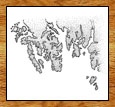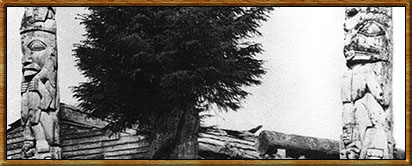 
|
Sukkwan

Sukkwan is the Haida version of a Tlingit name meaning Town on the Fine Underwater Grass, a reference to the edible seaweed that grows there. John Work claimed it had a population of 229 people in the period between 1836 and 1841, including both Ravens and Eagles. Sukkwan was situated on a point of land, with five houses on the south side of the point and seven on the north. John R. Swanton recorded the names of seven houses, including Grizzly Bear House, Cedarbark Skin House, and Clay House (because it was painted with clay). Another was called Watery House after the name of a house at Kiusta, the town from which the people of Sukkwan came.
The pole of the middle house on the north side has a most unusual figure of the lazy son-in-law holding a small Whale in each hand. He wears a tall chief's hat with three potlatch rings, around which a strange creature is wrapped. It may be a Bullhead, judging by its prominent ribs at the back and its pointed horns, which are firmly grasped by the watchman figure on the top. The son-in-law stands on a Wasgo (or Sea Wolf), which has the small figure of a chief crouched between its ears; inside the ears are curved hornlike devices. The Wasgo also holds an insect in its mouth and has a small human between its knees. Sukkwan was abandoned in the late 1890s, and this pole was taken to the totem park at Hydaburg during a reclamation project in the 1930s.
|